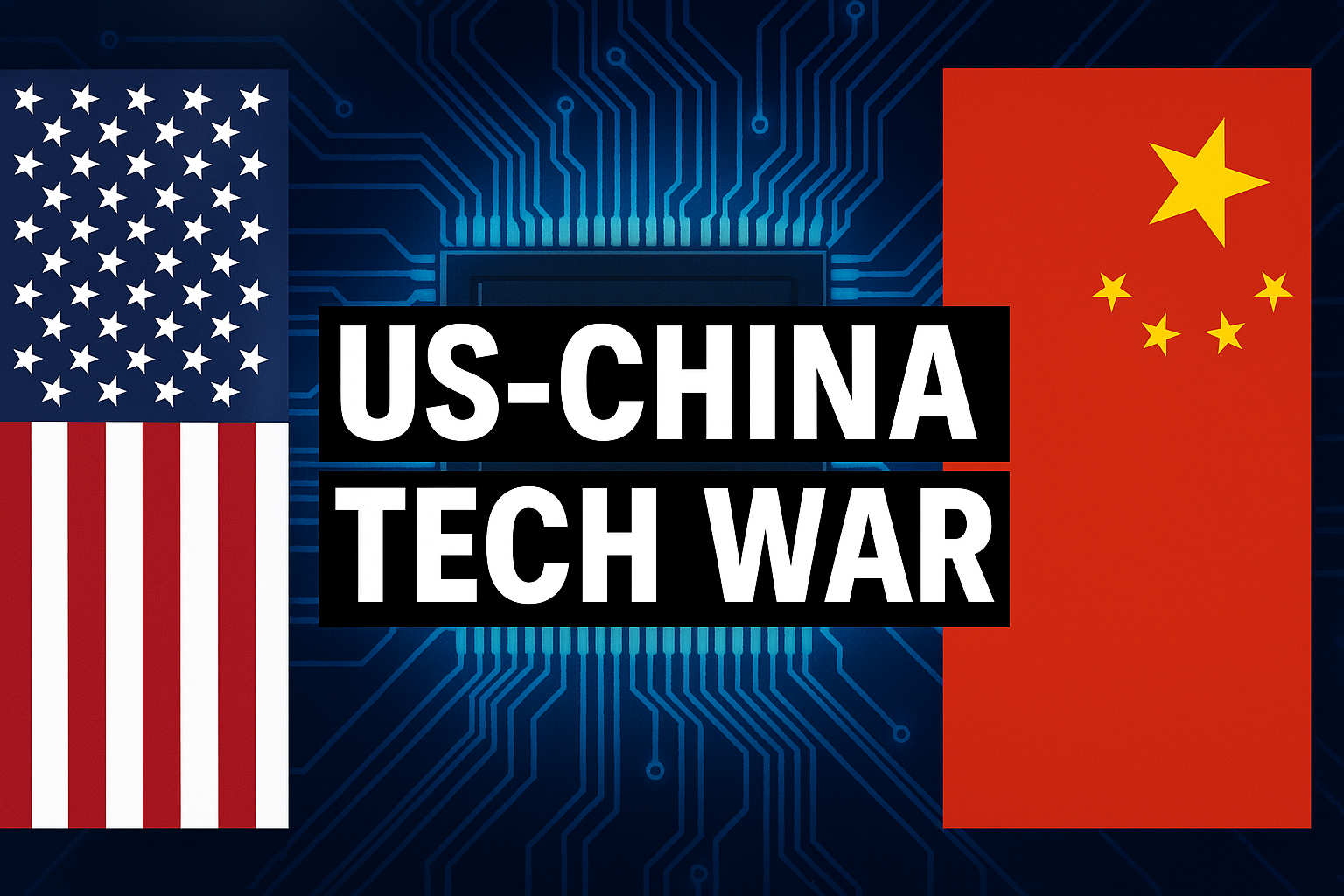Table of Contents
A Digital Cold War Begins
It all started quietly. One trade ban here, a tariff there. But before the world knew it, the US China tech war became the most defining conflict of the 21st century—one without bullets, but with code.
In an era where technology shapes economies, security, and societies, the US and China aren’t just competing—they’re locked in a digital arms race. And the consequences go beyond boardrooms or assembly lines; it touches everyday lives, global supply chains, and even what phone you might buy next.
This isn’t just news for CEOs and diplomats. It’s a frontline reality that affects all of us. I remember a conversation with a startup founder in Bengaluru who said, “Even our cloud infrastructure depends on who wins the US China tech war.” That’s how deep this battle runs.
Semiconductors: The Core of the Conflict
At the heart of the US China tech war is one tiny, powerful thing: the semiconductor chip.
Semiconductors power everything—from your smartphone to advanced military systems. And the US has historically led the world in semiconductor innovation through companies like Intel, AMD, and NVIDIA.
But China? It wants in.
In 2015, China launched its Made in China 2025 plan, targeting chip independence. The move wasn’t just economic; it was strategic. By reducing reliance on US chip technology, China aimed to build an ecosystem immune to American sanctions.
In response, the US dropped a bombshell: export restrictions on companies like Huawei. American firms were banned from supplying chips and software to Chinese tech giants. This shook China’s tech sector. Huawei’s phone business, once a global contender, lost access to Google’s Android and vital chipsets.
Real case:
In 2022, the US tightened rules to block Chinese access to advanced AI chips, including NVIDIA’s A100 and H100 GPUs—critical for training AI models. This wasn’t just a trade policy; it was a pre-emptive strike in a growing AI race.

5G and Telecommunications: The Huawei Ban
Ask anyone about the US China tech war, and Huawei is the first name that pops up. For good reason.
Huawei was set to dominate global 5G networks. It offered cheaper and faster rollout options than its Western counterparts. But the US saw danger.
American officials claimed Huawei’s equipment could be used for espionage by the Chinese government—though hard evidence was never publicly shown. Still, the US acted, urging allies to block Huawei from their 5G plans.
Countries like Australia, the UK, and Japan followed. Others hesitated.
I remember during a trip to Singapore, I overheard a telco executive say, “We’re caught in a storm. Go with Huawei, and we risk losing US partnerships. Reject Huawei, and we lose cost advantage.”
That’s how geopolitics trickles down to corporate boardrooms.
The US China tech war in telecom has reshaped how countries choose their network providers. It’s no longer about price or speed—it’s about allegiance.
AI Supremacy: Algorithms vs. Algorithms
Artificial intelligence is the next frontier of power. And both nations know it.
The US dominates in foundational AI research, with institutions like OpenAI, Google DeepMind, and Meta AI pushing the boundaries. But China? It has data—lots of it—and the government backing to accelerate AI deployment across sectors.
Here’s a chilling stat: by 2030, China aims to become the global AI leader, surpassing the US in innovation and implementation.
During the COVID-19 outbreak, Chinese cities used facial recognition, predictive AI, and big data to enforce lockdowns and manage outbreaks. That level of tech coordination showcased how China is deploying AI at scale.
In 2023, the US passed the CHIPS and Science Act, pumping over $50 billion into domestic chip production and AI R&D to stay ahead. This move was clearly part of the larger US China tech war strategy.
But here’s the catch: innovation in AI needs hardware. And advanced GPUs come from American companies. China’s restrictions mean it’s locked out of the very tools needed to compete in deep learning.
One senior engineer I met in Bengaluru working for a Chinese-funded AI firm put it bluntly, “We have the minds, but not the machines.”
Cybersecurity and Espionage: Digital Spies in the Network
Let’s not pretend this tech war is just about money and patents. Espionage is real—and messy.
Over the past decade, the US has accused Chinese state-backed hackers of stealing intellectual property from American firms. Cyberattacks targeting defense contractors, pharmaceutical companies, and tech startups have raised alarm bells.
Case in point: The 2017 Equifax hack, which exposed personal data of 147 million Americans, was allegedly linked to Chinese military hackers.
In retaliation, the US has doubled down on cyber defense investments and offensive cyber capabilities through the Pentagon’s Cyber Command. Meanwhile, China is building its own cyber fortress through the Great Firewall and other surveillance tools.
This layer of the US China tech war isn’t seen by the public. It happens in server logs, firewalls, and data leaks. But it’s just as dangerous as a missile strike—just quieter.
The Battle for Standards and Influence
Tech isn’t just about who builds the best gadget—it’s about who sets the rules.
From 5G to facial recognition standards, the US and China are competing to influence international regulatory bodies like the International Telecommunication Union (ITU) and the International Organization for Standardization (ISO).
Why does this matter?
Because whoever sets the standard gets first-mover advantage. Imagine if China’s standards for surveillance tech become the global norm—that could shift the balance of power in how governments track, control, and monetize citizens.
The US China tech war isn’t only about technology. It’s about reshaping digital norms.
Real-World Fallout: Impact on Global Startups and Consumers
Let’s zoom out.
If you’re running a startup in India, Germany, or Kenya—you’re feeling this war too. US sanctions can block your access to certain Chinese components. Meanwhile, Chinese apps are facing bans or privacy reviews in multiple countries due to geopolitical pressure.
I run a small tech blog, and even hosting providers I work with have started flagging tools linked to Chinese APIs. That wasn’t the case five years ago.
The US China tech war affects:
- What phones we buy
- What chips go into smart cars
- What apps are allowed on app stores
- How data is stored and where it flows
It’s a domino effect. And for many businesses, navigating this war means choosing sides, often unwillingly.
China’s Response: Building a Tech Fortress
When the US tightened chip exports, China didn’t just complain—it doubled down.
The government boosted investment into local semiconductor startups. Giants like SMIC (Semiconductor Manufacturing International Corporation) began receiving billions in funding. The goal? Tech self-reliance.
But here’s the harsh truth: catching up in chip manufacturing is not a sprint. It takes decades of R&D, talent pipelines, precision equipment, and global trust. And even with money flowing, China struggles to match the capabilities of Taiwan’s TSMC or America’s Intel and NVIDIA.
Still, progress is visible. In 2023, China launched a 7nm chip for smartphones, shocking analysts who believed it couldn’t without ASML’s EUV machines. Although it’s still behind the curve, it shows China’s ability to work around bans.
One Chinese engineer I spoke with anonymously said, “It’s not about beating the US next year. It’s about building an ecosystem so that by 2030, we don’t need them at all.”
That’s the mindset driving the US China tech war deeper—this isn’t a trade spat; it’s a long-term decoupling.
Tech Decoupling: A Risky Divorce
For decades, global tech was one big family. American chips, Chinese factories, European software—all working together.
Now? That global village is splitting.
The US China tech war has triggered a tech decoupling movement. The US is “onshoring” semiconductor production with the CHIPS Act. China is building alternatives to Google, Android, and AWS.
Some visible shifts:
TikTok facing US bans and forced sales
Apple moving production to India and Vietnam
Chinese firms creating their own GPU lines
Alibaba and Tencent reducing reliance on US-based cloud services
But there’s a big risk: fragmentation.
If tech ecosystems diverge too much, we might end up with two separate internets—one US-influenced, one China-influenced. Think Android vs. HarmonyOS. Google vs. Baidu. AWS vs. Alibaba Cloud.
As a consumer, it means compatibility issues, security concerns, and limited access to global platforms. For developers? It’s double the work to adapt across ecosystems.
The US China tech war is creating walls in a digital world once built on bridges.
Startups in the Crossfire
Startups usually live in a world of hustle, code, and coffee—not geopolitics. But in the US China tech war, they’ve become collateral damage.
For instance:
US startups working on AI can’t sell advanced models to Chinese companies
Chinese investors face increased scrutiny in US tech deals
Open-source communities are being forced to choose sides
One Indian fintech founder told me, “We pitched to a US VC, but they backed out when they saw we had a Chinese partner on our cap table.”
Even in developer communities, tension is rising. GitHub once suspended accounts from certain Chinese universities due to US compliance rules.
Startups that once thrived in a global market are now walking on eggshells, tiptoeing between regulations, sanctions, and policy shifts.
The US China tech war isn’t just about empires clashing—it’s about how small innovators get crushed between them.
Education and Talent: Brain Drain or Brain Gain?
Behind every chip and algorithm is a human mind. And both countries are battling for brains.
Historically, the US benefited from top Chinese talent studying at MIT, Stanford, and Berkeley. Many stayed back, contributing to America’s innovation engine.
But with rising tensions, visa restrictions, and suspicion, fewer Chinese students are choosing the US. Meanwhile, China is luring back talent with massive incentives—housing, grants, and research freedom.
Case study: Turing Award winner Andrew Chi-Chih Yao, once a professor at Princeton, returned to China to head Tsinghua University’s Institute for Interdisciplinary Information Sciences.
The US China tech war has triggered a shift in the global talent flow. If America shuts doors too tightly, it risks losing its edge in innovation.
And let’s be honest—as an Indian student considering tech research abroad, these developments make you think twice. Which country will let you build without bias?
India’s Role: Neutral Territory or New Superpower?
Now, let’s talk about the elephant in the server room—India.
Caught between two tech giants, India has emerged as a neutral ground and a rising player.
With a massive developer community, government-backed initiatives like “Make in India”, and growing semiconductor investments, India is slowly becoming a pivot point in the US China tech war.
Real shifts:
Apple expanding iPhone manufacturing in India
Micron setting up chip plants in Gujarat
India banning Chinese apps due to security concerns
Indian startups attracting US funding as alternatives to Chinese ventures
India’s diplomatic stance—being non-aligned—gives it leverage. It can host US tech firms while buying affordable hardware from China.
For Indian entrepreneurs, it’s an opportunity if played smartly. Build tech solutions locally, use global funding, and avoid entanglement in the East-West power play.
The Economic Cost of the Tech War
Every war has casualties—and in the US China tech war, the damage is measurable.
By some estimates, global GDP could lose over $3.5 trillion by 2035 if full tech decoupling happens. Delays in 5G rollouts, AI deployment slowdowns, and disrupted supply chains all cost money and time.
Major economic impacts:
Huawei lost $60 billion in revenue post-US sanctions
US chipmakers like Qualcomm and Broadcom saw sales dip when China retaliated
Consumers paying more for gadgets due to fractured supply chains
Even in the stock market, this war creates volatility. Every ban or policy change sends tech stocks tumbling. And in countries like India, where tech is a big investment theme, such ripple effects hit retail investors hard.
The US China tech war isn’t an isolated storm. It’s a global hurricane in the making.
Will There Be a Winner?
Here’s the big question everyone asks—who’s going to win?
The honest answer? No one wins a tech war. At least, not in the traditional sense.
The US might retain its lead in chips and AI research—but lose access to Chinese markets.
China might build self-reliant systems—but suffer years of lag and innovation bottlenecks.
Smaller countries might benefit as alternatives—but face diplomatic pressure.
Some analysts argue that the world will adapt to two systems: one built on American principles of privacy and open-source innovation, and the other driven by China’s model of control and scale.
But for consumers, developers, and businesses, this division creates more confusion than clarity.
The US China tech war is less about victory and more about redefining the tech order.
Author’s Commentary: How It Changed Me
I used to think of tech as this cool space for innovation—apps, gadgets, tools.
But the US China tech war made me realize tech is power. It’s politics. It’s war—just in a cleaner interface.
As someone running a tech blog and building tools for creators, I’ve had to re-evaluate the APIs I use, the platforms I promote, and even the hosting partners I choose. Everything now comes with a geopolitical label—“Is it safe?” “Is it legal?” “Will it be blocked next week?”
This war made me cautious but also made me think global. The need for open systems, neutral infrastructure, and cross-border collaboration is clearer than ever.
Technology must serve people—not power struggles.
Frequently Asked Questions (FAQ)
Q1. What is the US China tech war?
The US China tech war is an ongoing conflict between the United States and China focused on technology leadership, including semiconductors, AI, 5G, cybersecurity, and trade restrictions.Q2. Why did the US ban Huawei?
The US claims Huawei’s 5G equipment poses a national security threat due to possible ties with the Chinese government. Huawei denies the allegations.Q3. How does this tech war affect consumers?
Consumers may face higher prices, limited access to certain devices or apps, and compatibility issues due to fragmented tech ecosystems.Q4. Can China really catch up in chip technology?
China is investing heavily in semiconductor R&D but faces challenges due to limited access to advanced chipmaking tools and global sanctions.Q5. Will this tech war ever end?
It may not “end” traditionally. Instead, the world may adjust to a new normal with two distinct tech ecosystems driven by US and Chinese policies.
Quantum Tech: The Next Battleground
As the US China tech war marches forward, we’re entering the next frontier of innovation—quantum computing. This is where things get really interesting (and a bit mind-boggling).
Why? Because quantum tech isn’t just a game-changer for computing power—it could rewrite the rules of encryption, AI, and the global economy.
Here’s the kicker: the first country to dominate quantum tech will have access to unbreakable encryption, solve complex algorithms in seconds, and change the way artificial intelligence learns.
Both the US and China know this. In fact, China has made significant strides in quantum communications and quantum cryptography, even launching a quantum satellite that has been in operation since 2016. The US, meanwhile, is investing billions through programs like the National Quantum Initiative to build a quantum infrastructure.
The US China tech war is now moving into this space, and quantum research is becoming a crucial part of national security. Imagine a scenario where one country can decrypt the other’s secret data in seconds—no firewall or encryption algorithm could stop it. That’s the future we’re headed towards, and it’s happening right now.
The Space Race 2.0: Tech in Orbit
If you thought the US and China were only battling it out on the ground, think again. The US China tech war has extended into space.
Both countries are ramping up efforts in space exploration and satellite technology. China’s space agency, CNSA, has been making headlines with its ambitious lunar missions, Mars rover projects, and satellite networks.
In the meantime, the US—led by NASA and private space giants like SpaceX—is pushing forward with its own space exploration initiatives. The US is focusing on things like the Artemis Program to return humans to the Moon and Mars.
Space tech isn’t just about exploring the unknown—it’s also a strategic play for future technology. From global positioning systems (GPS) to satellite internet, space tech underpins everything from navigation to communications.
In the US China tech war, who controls the space frontier controls the next wave of technological influence.
Privacy and Surveillance: The Battle for Control
Now let’s talk about privacy—because the US China tech war has far-reaching consequences on how our data is collected, used, and protected.
For the US, privacy is a cornerstone of its tech policies. With laws like GDPR and California’s CCPA, the US emphasizes data privacy, transparency, and consumer rights. But the US China tech war is starting to challenge these ideals.
China, on the other hand, takes a more state-driven approach to tech control. The Great Firewall restricts access to foreign platforms like Facebook and Google, but it also creates a robust domestic surveillance infrastructure. This system tracks everything from social media activity to shopping habits, facial recognition, and even political views.
In the US China tech war, privacy is no longer just a personal issue—it’s about national security. The US has accused Chinese companies like Huawei and TikTok of spying on American citizens, while China claims the US is using data for geopolitical leverage.
For consumers, this means more oversight, more security risks, and less control over how our personal data is used. While privacy advocates push for stronger regulations, the US China tech war continues to challenge the notion of data sovereignty.
Predictions for the Next Decade: A Split World
The future is uncertain, but one thing is clear: the US China tech war is likely to reshape the world in ways we can’t even imagine. Here’s what we might expect over the next decade:
- Two Separate Ecosystems: We might see two tech ecosystems emerge—one led by the US and the other by China. This could lead to parallel versions of the internet, cloud services, and app stores—each catering to its own sphere of influence.
- Increased Decoupling: The US and China are moving away from each other in terms of technology, trade, and even talent. This decoupling will continue, with countries like India, Japan, and South Korea serving as key players who navigate between these two giants.
- AI Arms Race: The race to develop artificial general intelligence (AGI) and autonomous technologies will escalate. Both the US and China will invest heavily in AI, but this will bring about new geopolitical challenges, as AI becomes a national security asset.
- Tech Diplomacy: Expect new diplomatic channels to open, where countries will need to negotiate not just on trade or security, but on technology standards, data-sharing agreements, and intellectual property rights.
- Cybersecurity Overdrive: With cyberattacks being a key part of the US China tech war, both countries will continue to build their cyber capabilities. Expect a massive increase in cyber espionage, hacking attempts, and data breaches as part of this ongoing battle.
In short, the next decade will see a fractured world where tech becomes the ultimate weapon in global politics. The result? More complex, more secure, but less unified global systems.
What Happens to the Consumer?
So, what does all of this mean for you and me—the everyday consumer?
- Price Hikes: As global supply chains are disrupted, we may see price hikes in everything from smartphones to 5G equipment. Tariffs, import/export bans, and shifting alliances will likely result in higher costs for consumers.
- Tech Choices: The US China tech war will limit your options. Certain Chinese apps and services may be banned or heavily restricted, while new alternatives may take their place. It’ll be a game of which country’s tech you can access, rather than just the best tech available.
- Security Concerns: With the rise of surveillance technologies, your personal data may be more exposed than ever. Expect more tracking and less control over your digital footprint.
- Innovation Slowdown: As both nations focus more on strategic tech dominance than global cooperation, we might see a slowdown in groundbreaking, collaborative innovations. Tech’s potential to solve global problems may be stifled by nationalist policies.
Solutions and Neutral Pathways: Can We Find a Middle Ground?
Despite the rising tensions, there’s hope. The world doesn’t have to split into two hostile camps. There’s a middle ground where countries and companies can collaborate without compromising security or innovation.
Here are some potential pathways:
- Global Tech Standards: The US China tech war underscores the need for global tech standards that aren’t driven by any one country’s interests. Global collaboration on things like AI ethics, 5G infrastructure, and cybersecurity protocols could pave the way for a safer, more inclusive digital future.
- Tech Diplomacy: Countries that aren’t involved in the US-China rivalry—like India, Germany, or Brazil—could play a diplomatic role in bridging the divide. By promoting multilateral dialogues, these nations could help mitigate the impact of this tech war on smaller economies and businesses.
- Fostering Innovation Through Cooperation: Despite the geopolitical tensions, both the US and China benefit from innovation. Encouraging collaborations in areas like quantum computing, renewable energy, and healthcare tech could help shift the focus from competition to cooperation.
The hope here is that we, as a global community, realize that tech wars don’t just hurt the superpowers—they hurt everyone. A fractured tech world could leave us all worse off.
The Digital Battlefield
The US China tech war is more than just about chips, networks, or data centers. It’s about the future of global technology, the distribution of power, and the control of digital landscapes.
As the war continues to unfold, it’s clear that the winners and losers will not just be limited to Washington or Beijing. Everyone—whether in Silicon Valley, Shenzhen, or your hometown—will feel the effects.
For now, we wait to see how this tech battle plays out. But one thing is for certain: in the US China tech war, the real cost may not be in dollars—it could be in the very freedom to innovate.
The US China tech war will likely shape the tech landscape for years to come. Whether you’re a consumer, entrepreneur, or developer, the best thing you can do is stay informed, stay adaptable, and keep your focus on how technology can improve lives—not just serve as a tool for global conflict.




Leave a Reply